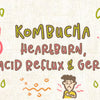Vinegar Eels: Identify And Combat!
Not Much Time? Skip To What You'd Like To Learn...
-
What Are Vinegar Eels?
-
Are Vinegar Eels Parasites?
-
How Do They Get Into Kombucha?
-
5 Ways To Prevent Vinegar Eels Getting Into Your Kombucha
-
5 Signs They're In Your Kombucha
-
What To Do If They're In Kombucha
-
Are Vinegar Eels Safe To Eat?
-
Starting Vinegar Eels With A Culture
What Are Vinegar Eels?
Turbatrix aceti, also known as vinegar eels, are a type of roundworm.
In kombucha, they feed on the yeast and bacteria culture. It can be quite unsettling to find in your jar of kombucha, especially if you have never encountered the 2mm worms. They are found floating about a quarter inch from the liquid surface. They often float in clumps to the most oxygen-rich part of the liquid.
Vinegar Eels vs. Vinegar Worms
As discussed vinegar eels, also known as Panagrellus redivivus, are worms. So vinegar eels and vinegar worms refer to the same species. They are nematodes (or roundworms). Nematodes are around 0.1 - 2.5mm in length. They are thin and live a variety of conditions, from saltwater to desserts. These eels are farmed and used as supplementary food for fish.
Are Vinegar Eels Parasites?

FDA classifies vinegar eels as non-parasitic nematodes and harmless to human beings. When consumed, they get digested in the stomach and do not interact with the gut bio. However, in as much as they are harmless to us, they are harmful to your kombucha and SCOBY. This is because they continue to feed on the yeast and bacteria culture.
How Do They Get Into Kombucha?

Using raw vinegar as a starter
Raw vinegar may sometimes contain vinegar eels. While they might be only a few to start, they usually multiply fast once they find favorable conditions. In the kombucha, they will feast on your SCOBY culture.
Using a contaminated SCOBY
If this is your first kombucha brew and you notice vinegar worms in your kombucha, then the likelihood is that the worms came with the SCOBY. Always inspect the SCOBY before beginning to ferment. If you detect the worms in it, do not use it. It will become infested.
Unhygienic brewing practices
Vinegar eels love yeast and bacteria cultures. Therefore, it is more likely that they infest an area where such food can be found. A dirty kombucha brewing operation makes the perfect environment. When the brewing equipment isn't sterilized before and after each brew, it can result in increased vinegar eel population. This means it could contaminate all future batches.
5 Ways To Prevent Vinegar Eels Getting Into Your Kombucha

1. Avoid using raw vinegar as a starter
As we saw earlier, raw vinegar could be infested with vinegar eels. The eels are not after the vinegar but the yeast and bacteria culture that's responsible for producing vinegar. If you must use raw vinegar, then it should be pasteurized to kill the eels.
2. Sterilize all equipment
Use hot water to sterilize the brewing equipment before setting up the brew. Alternatively, you can use concentrated (spirit) vinegar; it's important to note that this is very different from raw vinegar. It is much more acidic and doesn't contain eels.
3. Use the right starter fluid
Always use a 3:1 mixture of freshly brewed tea and previous batch's kombucha to prepare the starter fluid.
4. Avoid rinsing your SCOBY before brewing
Exposing the SCOBY to tap water may contaminate it and drains the acidity. This makes it much more favorable for vinegar eels to feed on. The exposure to water might also introduce vinegar eels on to the SCOBY, which leads to further infestation during the kombucha brewing process.
5. Avoid using infected SCOBYs
If you just received your first SCOBY, you should inspect it thoroughly to ensure that it's not infected. Do not use any contaminated SCOBYs.
5 Signs They're In Your Kombucha

1. Presence of abnormal disfigurement on the SCOBY
As the vinegar eels feast on your SCOBY noticeable disfigurements appear. If you notice signs of wasting away and SCOBY shriveling, then there's a high likelihood that your kombucha is infested with worms. They are feeding on the bacteria and yeast culture making it less healthy and smaller in size too.
2. Slower brewing rate
When the vinegar eels feed on the bacteria and yeast culture, they ultimately undo the existing symbiotic balance between the bacteria and yeast. As a result, the fermentation rate slows down drastically, and the kombucha takes much longer to brew.
3. pH
The fermentation process produces an acidic environment that also serves to protect the SCOBY from mold growth. As the SCOBY becomes weaker due to vinegar eel's infestation, the acidic environment is slowly lost. This will affect the pH balance.
4. Presence of visible worms floating near the surface
By the time these tiny worms have grown enough to become noticeable to the naked eye, then the entire jar needs to go down the drain. As the vinegar eels mature, they will clump up about a quarter inch from the surface where there's plenty of oxygen.
5. Foul taste
Kombucha that's been infested with vinegar eels quickly loses its flavor profile. The kombucha becomes less acidic and gains a nasty taste which cannot be associated with any of the ingredients or changes in fermentation condition.
What To Do If They're In Kombucha

If you have discovered vinegar eels in your kombucha, then it is time to dispose of it and take measures to prevent the same from infesting the next batch.
While some brewers usually use a fine mesh strainer to filter out the worms before consuming the kombucha, it's not recommended.
Dispose of everything
As there's no way of removing the eels entirely from the kombucha or the SCOBY, you will have to dispose of the entire batch including the SCOBY. Drain the liquid in the sink and proceed to dispose of the SCOBY. Vinegar eels can withstand a pH range of around 1.6 - 11, they are incredibly tolerant and therefore incredibly difficult to get rid of.
Clean the equipment
Use hot water and regular soap (not antibacterial) to clean the fermentation jar, lid, and any other tool that might have come into contact with the batch. This prevents future infestation.
Sanitize the equipment
Use distilled white vinegar to rinse out the kombucha equipment. This is strong enough to kill any of the nematodes that might have survived the hot water.
Are Vinegar Eels Safe To Eat?

Technically vinegar eels are safe to eat as they cannot harm the body. After a few days, they will be out of your gut system together with other excreted matter.
Are they bad for you?
No, as they are not parasites, and they do not interact with your gut bio or produce any chemicals that might upset your stomach.
Starting Vinegar Eels With A Culture

If you have an aquarium populated with fry or even adult fish, then there's no need to throw away the vinegar eels. These can be used as the perfect source of protein for your fish when mixed with apple cider vinegar and sugar.
Instead, you should use the infested kombucha to culture vinegar eels. This is because female vinegar eels can give birth every 6-10 days to up to 45 young ones. These can live for up to 10 months, ensuring that you have a self-replicating source of fish food.
How To Start A Vinegar Eel Culture:
1. Prepare the growing area
Vinegar eels are not picky and only require a source of food, oxygen supply, and optimal temperatures which are between 60 to 90 degrees F (15 to 35 degrees C). Use a clear plastic or glass container, preferably one with a wide circumference to increase the surface area exposed to air.
2. Prepare the culture
Mix in 3 parts apple cider vinegar and 1 part non-chlorinated water in a bowl and add one teaspoon of sugar, mix until completely dissolved. This will provide the required nutrients to keep the eels growing.
3. Add in the vinegar eels
If you already have a jar of kombucha that's been infested with eels then drain it into the large container and mix in with the cider vinegar.
4. Cover the growing area
Place cheesecloth over the mouth of the container and hold it into place with a rubber band. This ensures air freely flows into the container while also keeping off contaminants and other organisms such as fruit flies.
5. Store the culture away from your fermenting projects
Keep the container of eel culture away from your kitchen and other fermenting projects to avoid a repeat of the same. Eels do not have any light related requirements and can, therefore, be kept away from sunlight.
How To Use:
Vinegar eels can be harvested from the growing culture by using coffee filter paper to filter them out and transfer them into the aquarium. Here the fish will feed on them as they wish. Eels are much better than other sources of food as they do not rot once transferred into the aquarium and also the fish cannot overfeed on them.







